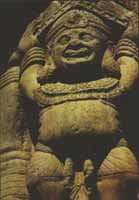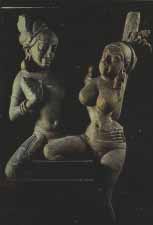YAKSAS AND WATER COSMOLOGY
A.K. Coomaraswamy’s celebrated work on Yaksas unfolds the multi-layered symbolism of Water Cosmology. IGNCA has republished the book with additions to open up new vistas for discussions amongst students of Indian Art.
Dr. KAPILA VATSYAYAN in her profound Foreword to the book critically evaluates the concept and brings forth the subtle nuances of Yaksas at the both ends of micro – and macro-contexts encompassing the whole cosmic dimensions.
Yaksas provides a meaningful insight into A.K. Coomaraswamy’s growth from a botanist-geologist to an art-historian and philosopher. He began by working on organic and inorganic matter, paddy fields, rice cultivation, earth and rocks and moved swiftly from matter to form, from form to content and from content to essential principles to symbolism and finally to the realms of the spirit.
Yaksas is a micro-model of this process of development. Yaksas, Part 1, appeared in 1928 and was followed by Part 2 in 1931. Within the brief intervening period of three years, Coomaraswamy had traveled to multi-planes of investigation. He later added a significant Appendix (printed in this book as Part 3), which explores more deeply the philological aspects, and moves from consideration of a pervasive art motif to fundamental concepts and symbolism.
The early Coomaraswamy dwells at length on issues of history, ethnology, archaeology and chronology. Later, understandably, these are so well assimilated and digested that his concern shifts to interpretation, reflection and speculation. The transition is nowhere so clearly evident as in the two parts of the Yaksas. In Part 1, he examines the origin of the Yaksas in the context of Vedic, Brahmanical and Upanisadic literature as also the theories held by writers such as Fergusson in his monumental work Tree and Serpent Worship and also Dr. Vogel in Indian Serpent Lore. For his predecessors, the Yaksas seem to represent the primitive faith of the aboriginal casteless Dasyus who inhabited northern India before the advent of the Aryans. Modestly, Coomaraswamy declares: “In this volume I have attempted to bring together, from literary and archaeological sources, material sufficient to present a fairly clear picture of an even more important phase of non – and pre-Aryan Indian ‘animism’, the worship of Yaksas and Yaksis to indicate its significance in religious history and iconographic evolution”.
In the pages that follow, Cooraraswamy examines the literary material and sculptural evidence. His sources are vast, ranging from Grhya sutras to the Satapatha Brahmana, to the Buddhist and Jaina sources. He traverses this primary material with consummate skill. He draws attention to the etymology of the word ‘Yaksas’ from perhaps the root jay (to worship) or from pra-yaks (to honour) as also the yakkhas mentioned in the Digha Nikaya and Mahavamsa as also Bhagavati Sutra and other Jaina works in Prakrit. From an examination of these sources, he initiates a very interesting discussion on the dual attitude towards the Yaksa, sometimes of fear, at other times, of respect. Also, this leads him to discuss whether yaksas can be or cannot be identified with raksasas on the one hand or Kubera and Ganesa on the other. As students of Indian art history know, the debate on whether Yaksas are malevolent or benevolent deities continues to engage attention. Coomaraswamy’s contribution lies in drawing attention to this textual material without ignoring folklore and ethnology and yet urging for understanding the importance of this motif beyond Tree and Serpent Worship. Coomaraswamy expands the canvas on consideration of this motif to several contexts and planes and meaningfully relates the Indian and Asian evidence as also Sanskrit, Pali and Prakrit sources. He develops his theme to include the Yaksa caity grha, i.e., Yaksa shrines as open spaces marked by Sacred Trees or as structural buildings. He speculates on “what were they like? “. He draws attention to reliefs of the Sanci stupa and also to the detailed description of a Yaksa shrine given in the Aupapatika Sutra. The brief discussion lays the foundation for a further exploration of Yaksa caity which awaits the attention of scholars. Of equal significance are the section s on worship (puja) in Yaksa shrines, and Yaksa worship as a bhakti cult. Through examination of primary material he convinces us of the antiquity of puja (as distinct from yajna) and of the pervasiveness of bhakti beyond Visnu. Each brief section is an aphorism to open vast vistas of exploration.
He could have developed his argument to include a fuller discussion on the yaksis, but chooses to shift, as if, gears. In Part 2 he takes the reader to the interpretative levels of the artistic motif. It is here that the maturer Coomaraswamy delves deeper to unfold the Water Cosmology underlying what may appear on surface as either a minor deity or tutelary God or only an ornamental motif. With an uncanny insight, Coomaraswamy reveals that the Yaksas do not as much control the waters as mere waters but are the essence in the waters which is one with the serpent, tree or amrta or elixir of the Devas. In short, the seed in all living-beings. Hume has drawn attention to Water Cosmology from the philosophic discussion of the Upanisads. Coomaraswamy related the speculative philosophy to the artistic and concrete. By probing deeper into Vedic sources, this time, he also creates the bridge between Yaksas being termed purely in historical terms as representating the animistic of the Dravidian tradition or the early pantheistic and Vedic cosmology. This in itself was a bold and great accomplishment. In critical discourse of thirties, the Aryan and the Dravidian sources were not only being separated but had been placed in opposition. Although now accepted, at the time, Coomaraswamy’s statement that “Indian art is never illusionistic; it constitutes, in fact, a unity, and all the elements of this unity are congruous and coeval. Even to attempt to distinguish Aryan and Dravidian tendencies may represent in part a false issue” was as new and unconventional as was his other statement that “the origin of the Buddha image was in India and not Greece”.
Characteristically, Coomaraswamy does not restrict himself to the Indian literature on Water Cosmology. He draws attention to many ancient culture, e.g., those of Egypt and Iran. Through the examination of sources of Water Cosmology and the motifs of the Yaksas, naturally and logically, Coomaraswamy examines that other motif of Indian art which has attracted and repelled viewers and has continued to be a subject of discussion and interpretation, namely, the Mithuna. Few art-historians had dealt with the subject. It required some courage to do so because writers, such as Veincen Smith, had extensively decried such motifs as indicators of decadence of Indian art. O.C. Ganguly had written one or two articles on it, but no more. Coomaraswamy shows the connection between the Water Cosmilogy, yaksas and the idea of the productive pair Mithuna. Coomaraswamy goes further in succeeding sections to establish the connection of Water Cosmology, Yaksa and Mithuna to not only Varuna but also to the other motifs known to both Indian and European traditions, such as, the motif of the Holy Grail and, naturally, the Tree of Life.
The two volumes are full of material relating to the content, form, symbolism and cosmology of Indian art. This is a condensed compendium, as one might call it, of the essentials: the motifs – yaksas or yaksis, the Lotus of the Puranaghata, the makara or the river Goddesses which permeate and pervade all streams of Indian art. Each time the book is read, a new insight is revealed. It would be left to the students of Indian art to explore this condensed text with a view to manifesting its true proportions at different levels and periods of Indian art.
Paul Schroeder, an avid reader of Coomaraswamy’s writings, has examined many unpublished documents in the Princeton collection as also in A.K. Coomaraswamy’s personal papers with Dr. Rama P. Coomaraswamy. Prima-facie, it appears to be simple. As Mr. Schroeder proceeded with editing the work, he realised the vast extensive sources utilised by Coomaraswamy, both literary as also archaeological and sculptural. With infinite patience he has checked these sources diligently; has worked in Princeton and other libraries for editing this volume. In his introduction, he has painstakingly updated critical writing on Water Cosmology by art-historians as also draws attention to the relevance of this theme in the contemporary world where pollution of the primary elements – water, earth, air and fire – almost threaten extinction of humanity.
The republication of Yaksas Part 1 and Part 2, with the addition of new materials, will no doubt be welcomed by all students and scholars of Indian art today. It is a seminal, critical text and its accessibility will facilitate further research and interpretation.






